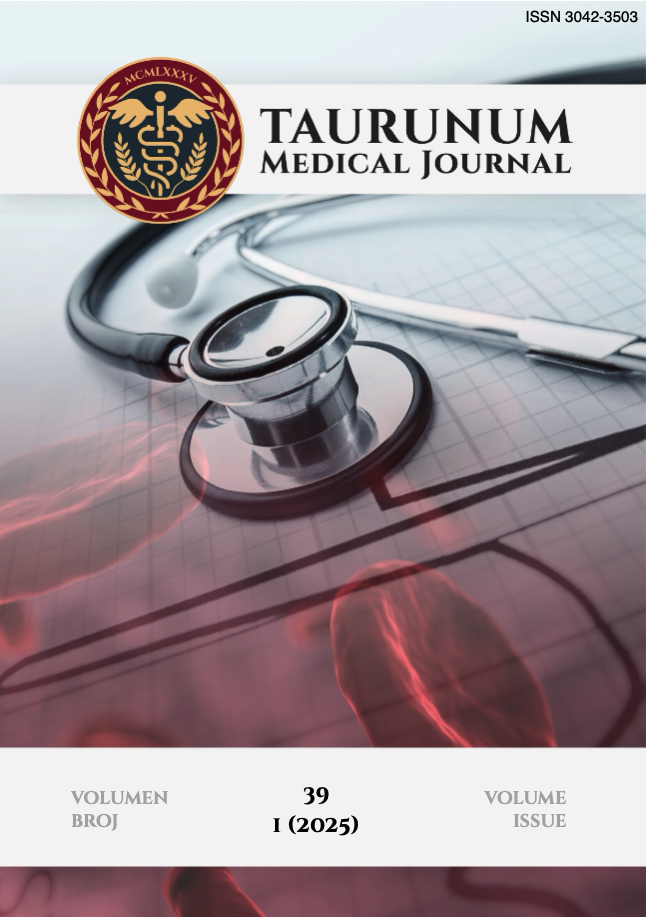Current issue

Volume 39, Issue 1, 2025
Online ISSN: 3042-3511
ISSN: 3042-3503
Volume 39 , Issue 1, (2025)
Published: 31.03.2025.
Open Access
Welcome to Issue 39, No. 1 – the first of our two annual publications for this year. Inside, you'll find a curated selection of articles. Start your year with the essential knowledge and perspectives offered in this timely edition
All issues
Contents
01.12.2010.
Review Article
OrIGINaLNI radOVI OrIGINaL arTICLEs Analiza rezultata posthemioterapijske retroperitonealne limfadenektomije kod pacijenata sa intermedijarnim i lošim rizikom neseminomskih tumora testisa
Cilj ove studije je procena rezultata lečenja pacijenata sa intermedijarnim i lošim rizikom po kriterijumima “International Germ Cell Cancer Collaborative Group” (IGCCCG) metastatskih neseminomskih tumora testisa (NSTT) pomoću hemioterapije i retroperitonealne limfadenektomije (RPLA). U periodu od 1982do 2005, 82 pacijenta sa metastatskim NSTT, klasificiranih kao intermedijarna (65) i loša (17) rizična grupa po IGCCCG kriterijumima, su imali posthemioterapijsku (PH)-RPLA za srednje praćenje od 95meseci. Srednji dijametar RP rezidualne mase (RM) je iznosio 3.0 cm, 15 (18.3%) pacijenata je imalo povišene vrednosti tumorskih markera u serumu (TMS) pre PH-RPLA. Dvadeset i sedam (32.9%) pacijenata je iziskivalo administraciju hemioterapije druge linije, a kod 75 (91.5%) RP RM je kompletno resecirana. Retroperitonealna histološka analiza je pokazala prisustvo fibroze kod 20 (26%), teratoma kod 36 (42%) i vitalnog karcinoma kod 26 (32%), sa preživljavanjem u 76%, 80% i 38%, respektivno. Pacijenti podvrgnuti drugoj hemioterapijskoj liniji su imali signifikantno veću učestalost vitalnog karcinoma na PHRPLA (49% prema 24%)(P<0.001). Pacijenti sa lošim rizikom NSTT nisu imali signifikantno veću verovatnoću progresije (47% prema 55%)(P=0.5) i gori ishod (53% prema 69%)(P=0.2) nego sa intermedijarnim rizikom. Analiza pacijenata koji su primali hemioterapiju prve linije pokazuje signifikantno veću verovatnoću slobode progresije (VSP) (66% prema 41%) i bolje preživljavanje (74% prema 48%)(P<0.01) posle PH-RPLA nego oni koji su primili hemioterapiju druge linije. Konstatovano je bolje preživljavanje kod pacijenata sa prvom prema drugoj liniji hemioterapije pre PH-RPLA u pogledu nalaza na RP histologiji kod fibroze (94% prema 20%), teratoma (88% prema55%) i vitalnog karcinoma (54% prema 23%)(P<0.001). Ukupno, 5-godišnja VSP i preživljavanja su iznosili 57%(95% IP, 50%-62%) i 69%(95% IP, 61%-77%). Multivarijantna analiza je pokazala da nepotpuna resekcija (P<0.001), veličina PH RM (P=0.01) i nalaz teratoma i vitalnog karcinoma (p<0.01) na PH-RPLA predstavljaju nezavisne prediktivne faktore za recidiv bolesti. Pacijenti sa uznapredovalim NSTT imaju dug vremenski interval do progresije kada se hemioterapija kombinuje sa resekcijom RM. Naši nalazi ukazuju da odgovor tumora na hemioterapiju u kombinaciji sa kompletnom resekcijom svih RM, predstavlja garanci
Djordje Argirovic, Aleksandar Argirovic
01.12.2010.
Review Article
OrIGINaLNI radOVI OrIGINaL arTICLEs Pure testicular teratoma in adults: experience in the treatment of 49 consecutive cases
The aim of the present study is to analyse fate and survival in patients with pure testicular teratoma (PTT) according to clinical stage (CS) and applied therapy. Among a survey of 1275 patients with nonseminomatous germ cell testicular tumors (NSGCT) observed from January 1982 and June 2005, we indentified 49 (4%) patients with PTT. In CS I, 3 (15%) of 20 patients on surveillance relapsed. Complete response (CR) is achieved with chemotherapy in 1 patient and combined with postchemotherapy retroperitoneal lymphadenectomy (PC RPLA) in 2 patients (fibrosis 1, teratoma 1). Four patients managed with primary RPLA had universal survival. Among 4 patients treated initially with primary chemotherapy due to persistently elevated serum tumor markers (STMs) postorchiectomy, 1 patient died at 18 months. In CS I, 27 (96%) of 28 patients are alive and free of disease (AFD) at median follow-up (MFU) of 161.6 months. In the PC group, 1 patient with partial response (PR) is lost to follow-up at 6 months, 1 patient died of disease at 27 months. Eight patients achieved CR with induction chemotherapy, whereas only 1 patient relapsed at 24 months and is rendered free of disease with RPLA (teratoma). Twelve patients underwent PC RPLA due to PR following induction chemotherapy, combined with thoracic cytoreductive surgery in 2 patients. RP histology demonstrated the finding of fibrosis in 2, teratoma in 8, teratoma with malignant transformation in 1, and vital carcinoma in 1. The patients with fibrosis, teratoma and teratoma with malignant transformation are AFD, whereas the patient with vital carcinoma on desperation RPLA died. According to initial CS IIB, IIC and III PC surgery was indicated in 20%, 91% and 50%, relapse rate was 0%, 18% and 20%, with disease specific survival (DSS) in 100%, 90% and 100%, respectively. At MFU of 189.7 months, 19 (95%) of 20 fully available patients are AFD. Overall, 46 (94%) patients had no evidence of disease (NED) at last follow-up. These data underscore the metastatic potential of PTT. A significant proportion (32%) of patients with low-stage PTT had RP disease. Furthermore, a high proportion (36%) presented initially with advanced disease and demonstrated a considerable risk of relapse despite complete resection or favorable histologic features in the resected surgical specimen.
Djordje Argirovic, Aleksandar Argirovic
01.12.2010.
Review Article
Pathologic findings and clinical outcome in patients undergoing retroperitoneal lymphadenectomy after multiple chemorherapy regimens for metastatic nonseminomatous testicular tumors
We reviewed our experience with retroperitoneal lymphadenectomy (RPLA) after multiple cisplatin-based chemotherapy regimens in nonseminomatous testicular tumors (NSTT) patients and specifically evaluated clinicopathologic and treatment trend in addition to potential predictors of survival. Fort-one patients with NSTT underwent their RPLA between 1982 and 2005 after ≥ 2 regimens of chemotherapy. Thirteen patients (32%) necessitate redo-RPLA, combined with nephrectomy in 6 patients. 13 extra-RP (ERP) resections were performed in 11 patients (27%), including pulmonary (7), neck (4) and liver (2) sites. Thirty patients (73%) are rendered free of disease and 26 (63%) obtained serologic remission. Nine patients who relapse, necessitated new salvage chemotherapy+surgery (3 teratoma, 6 vital carcinoma [VC]). Four of 9 relapsing patients (44%) are currently free of disease with redoRPLA. Alive, free of disease are 19 pts (46%) at median follow-up of 131 months. Study of RP pathology demonstrated the presence of fibrosis in 15%, teratoma in 39% and VC in 46%, with survival in 67%, 56% and 32%, respectively. Different histology occurred in 38% at redo-RPLA and in 64% at ERP resection in comparison to previous RP pathology. Univariate analysis of clinicopathologic parameters associated with VC at RPLA included RP masses ≥ 5 cm (p<0.05), elevated AFP (p<0.001) or HCG (p<0.05) and ERP resection (p<0.04). On univariate analysis survival was worse in patients with RP masses ≥ 5 cm (p<0.04), elevated AFP (p<0.05) or HCG (p<0.007), ERP resection (p<0.01) and VC (p<0.004). On multivariable analysis, a RP masses ≥ 5 cm (p<0.03) and VC (p<0.005) predicted a worse prognosis. Our data support the continued use of salvage RPLA in three separated groups of patients: 1. Patients who achieved a complete response (CR) to 2nd -line chemotherapy and have no radiologic evidence of disease should undergo RPLA; 2. Patients who achieved a partial response (PR) to chemotherapy should undergo RPLA with ERP surgery, as indicated; 3. Highly selected group of patients with residual masses and elevated serum tumor markers (STM), particularly AFP, after chemotherapy may be candidate for surgery.
Djordje Argirovic, Aleksandar Argirovic
01.12.2010.
Review Article
OrIGINaLNI radOVI OrIGINaL arTICLEs Retrospective analysis of perioperative mortality after retroperitoneal lymphadenectomy for nonseminomatous testicular tumors
The present study is performed to determine whether retroperitoneal lymphadenectomy (RPLA) perioperative mortality (PM) rates reported from center of excellence [Indiana University: 0% for primary and 0.8% for postchemotherapy (PC) RPLA] are applicable to institution at large. Between 1975 and 2005, 327 assessable patients with nonseminomatous testicular tumors (NSTT) were treated with RPLA: primary in 134 (41%) and PC-RPLA in 193 (59%) patients. The observed PM rates were stratified according to age, clinical stage (CS) and type of RPLA. The median age at RPLA was 28 years (range 16-54) : < 29 years in 194 (56.3%), 30-39 years in 90 (30.3%) and > 40 years in 44 (13.4%) patients. Of 327 RPLA patients, 81 (27.8%) were performed for localized (CS-I), 179 (54.7%) for regional (CS-II) and 57 (17.5%) for metastatic (CS-III) disease. Ten (3.1%) patients died during initial 90 days after RPLA: 1 patient from pulmonary embolism, 2 of chemotherapyrelated toxicity and 7 of progressive disease due to preoperative worse prognostic factors. Of the entire cohort 30, 60 and 90-day PM rate was 0.3%, 1.0% and 1.3%, respectively. PM rate increase with increasing age: < 39 years 0%, 30-39 years 5.0% and > 40 years 9.3% (x2 trend test, P=0.002). PM rate also increased with CS: 0% localized, 2.8% for regional and 8.8% for metastatic disease (x2 trend test, p<0.001). PM rate at primary and PC-RPLA was increased with CS: 0% localized, 2.8% for regional and 8.8% for metastatic disease (x2 trend test, p<0.001). PM rate at primary and PC-RPLA was 0.7% and 3.1% 9P<0.001). RPLA was associated with virtually no or low (2.8%) PM rate in patients with localized and regional disease, respectively. In contrast, the PM rate of 8.8% for patients with distant metastases and group > 40 years of age (9.3%) implies that RPLA for these patients should be performed at centers of excellence, with intent of reducing PM rate.
Djordje Argirovic, Aleksandar Argirovic



